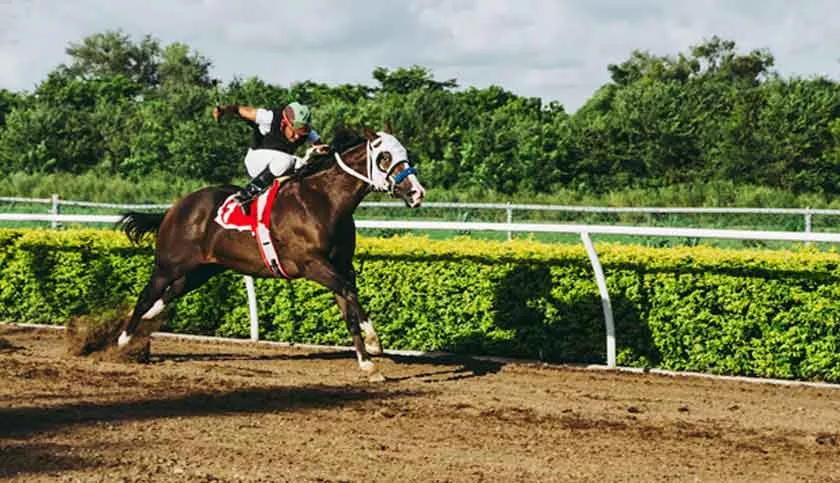There are many opportunities for bettors looking to win money. Choosing the right horse might be difficult, especially if you’re just starting, but it can also be fun.

Horse Betting Tips: How to Choose the Winning Thoroughbred
Horse racing is one of those games where several aspects must be evaluated for the winning horse to emerge. However, having an advantage before the race is critical for punters.
Before placing a bet, you must consider the jockey’s experience, the previous performance of the horse, its overall form, and a few more.
If you’re new to the sport and want to place a wager, we’ve compiled this helpful guide to pick your winning thoroughbred.
Pick The Right Jockey & Trainer
A horse may appear to be a good bet on the racetrack but has little chance of winning if it is not adequately trained. Similarly, a strong horse can never reach its full potential in the race unless paired with the right jockey on the day.
When betting on a winner, you’re picking a horse, a trainer, and a jockey. When you hear someone mention “hot jockey,” they’re not referring to their physical appearance.
It refers to a jockey who is well-known for his ability to win races. You can discover exciting horse races this Wednesday and see who’s the latest hot jockey on the track.
When selecting the right horse, the jockey’s experience is critical. Experienced jockeys are more familiar with the racetrack and the competitors. Furthermore, they are prepared to deal with any potential risk or challenging circumstance during the race.
As a result, experienced jockeys have a better chance of winning. Choose a horse that an experienced rider will ride. It will increase your chances of winning the race.
You should also find out if your horse and jockey have ever competed together and whether they perform better when competing.
That is why you should never overlook a horse’s past performances, jockey, and trainer – this should reveal whether they are all frequent winners, either on the track or behind the scenes.
Breeding and Pedigree
The racing industry relies heavily on breeding, with only the best horses reproducing at the end of their lives. The breeding can provide valuable information about how the horse may perform.
For example, if the horse’s sire and dam were both quick sprinters, it’s realistic to expect some of their speed to be passed down to their children.
Similarly, if both parents were 2-mile jump chasers, their children would eventually have more stamina.
Aside from the horse’s breeding, it would be best to look at its pedigree. A horse’s lineage influences multiple aspects, such as its stamina and how quickly it’ll reach its peak, especially if it is its first-time runner on the track.
A pedigree is a fancy name for a horse’s past generations, often known as his family tree. It tracks a horse’s ancestors back several generations. Knowing your horse’s bloodline history might help you detect probable personality traits or training concerns.
The Horses Form
The horse’s form is a record of a horse’s previous performances. The most recent form of a horse is usually posted next to or beneath its name.
It is a set of numbers and letters beside each horse’s name and shows where the horse has finished in previous races.
To read a form, you must start from left to right. The number on the far right reflects the horse’s most recent run and the horse’s finishing position.
In the form, various abbreviations are also used. A hyphen indicated the beginning of a new season, whereas a forward slash indicated the end of two seasons.
Age Of Horse
Another criterion to consider is the horse’s age, which may be listed in a column. The horse’s age is frequently listed to the right of the horse’s name. The age of a horse is not always necessary to know, but it can be helpful at times.
Remember that thoroughbreds sometimes begin racing at the age of two, and it is not uncommon for them to race before they age nine.
Horses who participate in flat races tend to peak earlier, between the ages of three and seven, whereas jumpers peak later, between the ages of seven and ten.
While a younger horse may appear to be a superior option, experience is essential in horse racing.
Distance
Looking at distances is an integral part of identifying victors and is one of the most visible elements. Most horses have a maximum distance they can travel on flat races and jump races before their stamina runs out.
Flat races are raced over a distance ranging from five furlongs to roughly two miles and six furlongs. The minimum distance in jumps racing is about two miles.
When selecting a horse, ensure it has the required speed, stamina, or a good combination of both, to perform well. It is possible to evaluate it based on previous results, how the horse has done, and the animal’s breeding, which usually reflects the horse’s favorite distance.
To Wrap it Up
It can be challenging to pick a winning horse, but the tips in this article will help you reduce the field to just one notable runner and perhaps a winning horse!
